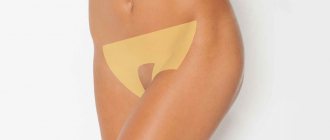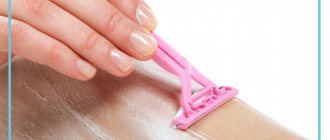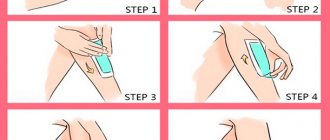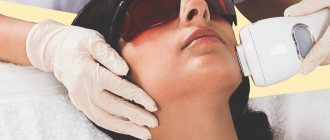The first laser hair removal procedure was performed in 1996. A ruby laser was used to remove unwanted hair growth. Soon it was replaced by more advanced technologies - alexandrite and diode lasers, the use of which makes it possible to solve the problem as physiologically as possible, without harm to health and with a guarantee of a positive result. However, questions about whether laser hair removal is harmful or not have still not lost their relevance. We will try to answer them by presenting expert information in an accessible form.
Types of laser hair removal
The type of laser hair removal depends on the type of lasers used for it. Today there are four of them.
- Ruby laser (used extremely rarely, as it is obsolete) with a wavelength of 694 nm, which destroys the hair pigment and does not have a detrimental effect on its follicle.
- Alexandrite laser (popular) with a wavelength of 755 nm, which effectively removes hair of any color growing on skin of phototypes I – IV.
- Diode laser (popular) with a wavelength of 808 - 810 nm, which is capable of removing dark and dark brown hair on skin of phototype I - VI.
- Neodymium laser (due to its “aggressive” effect is used in exceptional cases) with a wavelength of 1064 – 1320 nm, which affects the hair pigment and causes coagulation (sealing) of the vessels feeding its follicle.
Knowing the wavelength of light is necessary to estimate its absorption coefficient. Long-wave exposure easily reaches the follicle. On the one hand, this is good, but on the other, it means that its energy can be absorbed by competing skin chromophores (melanin and water contained in the tissue), which leads to a decrease in the effectiveness of hair removal. While short-wave radiation does not reach the follicle, it is poorly absorbed by skin chromophores, but it specifically affects the pigment of the hair shaft.
If we compare procedures on popular devices with each other, then hair removal with an alexandrite laser is considered more delicate. While the use of a diode laser allows you to treat darker skin of the face and body.
The benefits and harms of laser hair removal
The use of laser technology guarantees long-term results that can be successfully maintained throughout life.
Among the obvious advantages of the procedure, the following relevant points can be noted:
- non-invasive - without damaging the integrity of the skin;
- non-contact – only the laser beam affects the skin;
- painlessness - the use of cooling and local anesthesia eliminates discomfort;
- sterility – laser light energy demonstrates a bactericidal effect;
- versatility - the procedure is suitable for women and men with any skin type and hair color;
- high efficiency – all unwanted hair in the active growth stage is removed.
At the same time, directly opposite information about the uselessness and danger of procedures is actively discussed on popular forums and social networks. Its implementation is surrounded by myths reminiscent of “horror stories” about the dangers of laser hair removal for the body: they say it leads to the development of candidiasis (thrush), cancer and increased hair growth. It’s easy to refute these myths - it’s enough to have basic knowledge in the field of medicine and human physiology.
Laser light energy has a pronounced bactericidal effect. Its effect inactivates (destroys) pathogenic microorganisms, including fungi of the genus Candida, the active reproduction of which leads to the development of candidiasis.
Therefore, there are no negative consequences of laser hair removal in the bikini area. In this case, the exact opposite effect is observed: an absolutely clean field of “norm” - a complete absence of fungal infection, which is confirmed by the polymerase chain reaction method.
Laser light energy does not provoke uncontrolled proliferation (reproduction) of cells, characteristic of oncogenesis. Its exposure does not lead to the development of cancer! Moreover, recently lasers have been actively used in the treatment of cervical cancer, after chemotherapy and radiation therapy.
Laser light energy does not enhance hair growth. After all, this process is controlled by hormones that are produced in the endocrine glands of the body. During treatment of problem areas, the laser has no effect on them.
It is difficult to say on what basis such ridiculous myths are born, forcing girls to wonder whether laser hair removal is harmful to health. Answering this question, we can say with complete confidence that in the absence of contraindications and the procedure is carried out correctly, it does not cause any harm to the body.
Permanent laser hair removal in intimate places: types
There are several types of hair removal in and around the bikini area. They depend on the size of the area affected by the device.
Classic type of hair removal
This involves working with the hair roots along the edge of the underwear contour. That is, they heat the bulbs in a more visible area that is not covered by panties or swimming trunks. Hair is destroyed from the upper part of the pubis and inner thighs. This allows you to wear swimsuits and not think that you have to constantly remove something somewhere. This look is very traditional and acceptable by many women. For those men who, in principle, are not puzzled by the amount of hair on their entire body, this option is unattractive. But most often they prefer a different type of hair removal.
Laser hair removal for deep bikini
In this case, the hair removal procedure affects not only the swimsuit or underwear line, but also concerns getting rid of hair follicles on the entire pubic area and labia. This is a fairly intimate process that is trusted to qualified specialists. It involves being naked in front of a stranger. Most cosmetologists perceive such manipulation as something ordinary, but professionals will always treat your body with care, and your trust is no less important to them. On the Internet, by searching “” you can find videos that demonstrate the amazing effect of several sessions and the features of the procedure. Hair on the inside of the groin is also destroyed. All that remains is a neat vertical strip (the width, of course, is determined by the patient) on the pubis and in the perineum.
Complete hair removal in intimate areas
This is already mentioned about this type of procedure, you can find fans not only among women, but also among men. This type of manipulation includes complete hair removal in all intimate areas, including the skin between the buttocks. In this case, it is very important to find a cosmetologist to whom you are ready to demonstrate yourself without embarrassment, completely. Due to the intimate nature of the process, it is rarely filmed. So, total (meaning complete) hair removal occurs on the pubis, on the hips, and in the perineum or scrotum area, as well as in the gluteal folds and near the anus.
Contraindications for laser hair removal
Individual intolerance to laser radiation.
- Oncology.
- Insulin-dependent forms of diabetes mellitus.
- Herpes is in the acute stage.
- Epilepsy.
- Pregnancy, lactation period.
- Infectious, chronic diseases in the acute stage.
- Fresh tan.
- Multiple moles.
- Progressive benign skin neoplasms.
- Phlebeurysm.
- Wounds, damage, inflammation of the skin at the site of exposure, including tattoos.
- Predisposition to the formation of keloid scars.
- Systemic intake of medications that increase the photosensitivity of the skin.
- Chronic diseases, genital infections (in case of epilation of the bikini area).
Recommendations after the procedure
After the manipulations, the skin needs careful care. It is important to consider the following nuances:
- Avoid visiting the solarium and minimize exposure to the sun.
- Apply sunscreen before going outside. The SPF level should be at least 30.
- For the first 2-3 days after hair removal, avoid using decorative cosmetics.
- Choose skincare products only with gentle ingredients. They should be free of alcohol and acids.
- Apply anti-burn cream. It could be Panthenol.
- Avoid using aggressive sponges for washing your face.
- Do not visit the bathhouse, sauna or swimming pool.
The final result largely depends on the correct care after the procedure. It is important to follow the session schedule prescribed by the cosmetologist. If complications occur, consult a doctor immediately.
For a long-term effect without consequences, it is important to find a competent cosmetologist. Only modern and safe equipment is used. All cosmetologists have received higher medical education and take their work responsibly. During its operation, the salon received many reviews from grateful clients.
* — Information is valid at the time of publication of the article
Is it worth doing laser hair removal: indications for the procedure
Shaving, which has become traditional, is today considered not only outdated, but also a potentially dangerous method of hair removal. Using a safety razor at home causes microtrauma to the skin and can cause infection. It provokes ingrown hairs and the development of folliculitis (inflammation of hair follicles).
Often, irritation appears on the shaved area of skin in the form of small rashes and the effect of the so-called “blue beard” - when the subcutaneous part of the dark hair is visible, which does not look aesthetically pleasing. In addition, using a razor does not guarantee long-term smoothness - many women notice hair regrowth by the end of the first or second day after shaving. However, this is not a reason to use a laser.
Before you sign up for the procedure, you need to objectively weigh the pros and cons of laser hair removal. If we are talking about removing rare, unnoticeable hair that grows slowly and is not prone to ingrown hairs, then you can get rid of them using waxing or sugaring. Regular use of wax and sugar paste in a beauty salon or private office will help curb their unwanted growth without much difficulty.
When thinking about the need for laser hair removal, you should understand that to achieve a lasting result you will need to undergo a long course of procedures. Its duration is purely individual, after which it will be necessary to regularly carry out maintenance procedures and unquestioningly follow all the recommendations of the cosmetologist. Therefore, before deciding for yourself whether or not to undergo laser hair removal, you need to have time, money and be prepared for changes in your usual lifestyle.
Unwanted hair growth is not harmful to the body. Therefore, there are no direct indications for the use of laser. But analyzing the reviews of doctors about laser hair removal and the opinions of girls who have already completed the full course, it is still worth resorting to it.
Especially if you have the following list of problems:
- Large amount of unwanted hair.
- Dark, highly visible, coarse hair.
- Inconspicuous and light hair, as well as isolated gray hairs.
- Rapid hair regrowth after depilation.
- Irritation, redness, itching of the skin after using a razor, wax or sugar paste.
- Tendency of hair to ingrown.
- Folliculitis.
- Hairs on areas of the skin that are difficult to reach with razors, wax and paste.
- Bluebeard effect.
Laser hair removal easily solves these problems and guarantees long-term smoothness of the legs, armpits, bikini and other areas. A pleasant bonus is the improvement and improvement of skin quality at the site of exposure to laser light energy.
What is the difference between hair removal and depilation? Who is it suitable for? And what is more effective?
— It is necessary to distinguish between hair removal and depilation. Epilation is radical hair removal. Laser hair removal, for example, completely kills the reproductive apparatus of the hair; after completing the course, your hair will no longer grow in this area, and from procedure to procedure it will become thinner and sparse, turning into fluff. Hair removal is indicated for a wide range of people (skin and hair types), with very rare exceptions. Laser hair removal is not suitable for gray hair and those with very light vellus hair, practically without pigment (as hair pigment is a trap for light hair removal technologies). For redheads: laser hair removal can remove stiffness and make hair thinner, but radical removal will be problematic. To solve these problems, there is electrolysis.
Depilation is the removal of the hair shaft located above the surface of the skin: that is, shaving, tweezing, chemical hair removal, waxing, sugaring, electric depilatory, threading. But unwanted hair continues to grow, and this is a lifelong “struggle” and a high risk of ingrown hairs, post-traumatic pigmentation, roughening of the skin and the risk of secondary infection.
Is it a myth or truth that any such methods increase hair growth in the long run?
— I would advise, of course, to pay attention to laser hair removal - this is the only method that not only removes hair forever, but also rejuvenates the skin (improves its texture, making it smoother, tightens, removes minor vascular defects and pigmentation) and permanently resolves such an unpleasant and common problem as ingrown hairs, and from the first sessions. The laser is sterile, but home methods are not. But let's take it in order: if you use a razor (legs, arms, face), then vellus hair (and most of them on our body are thin, barely noticeable hairs) become hard and dark. That is, you essentially increase the area for depilation with these methods, which is what is associated with the myth that after depilation, hair can become larger. The razor often causes irritation and folliculitis. Electro-depilation partially damages and displaces the reproductive apparatus of the hair. The hairs become thinner, but they are guaranteed to grow into the skin over time. The fact is that we depilate our hair at random - against growth, along and across - and this leads to ingrown weakened hairs. During laser hair removal, there is a direct effect on the follicles, so the issue of ingrown hairs is resolved once and for all from the first session. More precisely, laser hair removal is a direct indication for the fight against ingrown hairs and folliculitis (irritation from ingrown hairs, acne).
Please tell us more about the reasons for the appearance of ingrown hairs. And is it still possible to deal with this problem at home?
— The process of ingrowth largely depends on the number of layers of scales of the epidermal layer and on its density. If there are many layers of epidermis on the surface, they make the skin dense and it is difficult for the newly growing thin hair to break through the protective layer. That is why the hair follows the path of least and less risky resistance, that is, it bends and grows not vertically, but horizontally. If you compare hair and skin types, people with coarse and dark hair are more susceptible to ingrown hairs than others. The reason lies in the fact that dark and coarse hairs grow more intensively than light ones.
Possible consequences of laser hair removal
Let’s make a reservation right away: complications after laser hair removal occur in three cases:
- the cosmetologist and his client ignored contraindications;
- errors were made during laser processing - incorrectly selected light wavelength, energy density, pulse duration, lack of cooling, etc.;
- laser equipment of dubious quality was used.
When faced with these problems, negative consequences cannot be avoided. Most often, girls complain of complications such as:
- burns;
- age spots or, on the contrary, “burnout” of skin pigment;
- formation of scar tissue;
- allergic rashes;
- soreness and increased sensitivity of the skin in the treated area;
- hematomas;
- folliculitis;
- active growth of vellus hair;
- development of photophobia and vision problems;
- exacerbation of herpes, chronic diseases, etc.
Of course, without being an expert in the field of laser hair removal and having resorted to the procedure for the first time, it is impossible to assess the quality of the device, the competence and correctness of the cosmetologist’s actions. Therefore, along with the question of why laser hair removal is dangerous, you need to ask another, no less important question - is it dangerous to do it in this particular beauty salon or clinic.
To answer it, you need to study reviews about the organization and the doctors working in it. There is no need to ignore a preliminary consultation with them, because during casual communication you can assess the competence of a specialist: if he is not interested in contraindications, does not warn about side effects, does not give recommendations for caring for the treated area and promises “mountains of gold”, then you should not trust him "cosmetologist".
How often is hair removal done and is it possible to permanently remove hair with laser?
The statement that laser hair removal eliminates hair forever is often misunderstood. From a medical point of view, complete hair loss implies a temporary or permanent cessation of hair growth. Laser hair removal allows you to achieve complete, temporary hair loss with the possibility of partial, long-term reduction in their number.
This formulation sounds rather confusing and incomprehensible, but in fact it means that after using the laser, hair does not grow for a long time, and when its growth resumes, it becomes very sparse and inconspicuous. Understanding this point is extremely important when setting expectations for laser hair removal. Otherwise, disappointment from the procedure cannot be avoided.
As for the frequency of treatments, it is purely individual - adequate to the speed of hair regrowth. On average, to achieve a sustainable result of complete hair loss, problem areas are treated once every 4 to 6 weeks. After which maintenance procedures are carried out - once every 12 - 24 months.
The reasons that lead to ingrown hairs are:
1. Changes in hormonal levels (with a surge of the hormone estrogen in the 1st half of the menstrual cycle). Such changes can also occur with dysfunction of the endocrine system and increased production of estrogen.
2. Damage during the epilation process of the hair canal.
3. Formation of a microscopic scar in the hair canal after depilation. Trauma can also cause the canal to become overgrown.
4. Hair injury (breaking off) below the level of the epidermis, which occurs as a result of improper hair removal.
5. Shaving, which is carried out against the hair growth, especially with a dull blade.
6. Wearing uncomfortable and tight underwear, especially made from synthetic materials. Such underwear does not promote the evaporation of moisture from the surface of the skin and often causes a bacterial infection. Therefore, it is not recommended to wear synthetic underwear immediately after hair removal, as in this case inflammation of ingrown hairs occurs.
I do not recommend dealing with this problem at home. Since any methods of “picking out hair” are a very high risk: post-traumatic pigmentation, scar formation, high risk of inflammation (secondary infection). This problem cannot be dealt with at home. You need to contact a cosmetologist.
What is the best way to remove unwanted facial hair?
— Eyebrows can be plucked with tweezers and corrected with thread. But vellus hair on the face in the area of the upper lip (moustache), chin, temples, forehead - it’s better not to. This is a very important area even for laser hair removal of the upper lip and other areas on the face. For example, about 2-5% of the hair on the upper lip is in the active growth phase, that is, it grows back very quickly. It is necessary to do 10-15 sessions even with a laser. If you shave, pluck, or wax, the hair becomes darker, coarser, and longer. These areas have sensitive skin, so you are guaranteed to experience constant irritation. Wax in 80% of cases leads to burns, the skin becomes pigmented, a dark stripe appears on the lips, which further emphasizes unwanted hairs. Laser hair removal on the upper lip takes minutes and costs about two thousand rubles. In eight months you are guaranteed to get rid of both hair and complexes.
However, it is better to remove hair not by zones individually, but in combination. For example, laser hair removal on the neck, ears, and full facial hair removal for men will cost less than epilation of individual areas.
What types of lasers are used for laser hair removal on the legs and other areas of the body?
Types of permanent hair removal methods: photoepilation, electroepilation, various types of lasers - alexandrite, diode, elos-epilation...
How are they different and which is more effective?
— At the moment, laser and ELOS hair removal are considered the most effective methods of hair removal. Again, because they allow you to completely solve the problem of unwanted hair on any part of the face and body in six months with maximum comfort for the patient. Usually, when a patient thinks about how to solve the problem of unwanted hair on the face and body, he/she usually considers three types of permanent hair removal: electrolysis, photoepilation and laser. Let's compare the methods.
Electrolysis VS Laser hair removal
Electrolysis seems at first glance to be more affordable, but this procedure is very painful, takes a lot of time (compared to a laser - hours, not minutes), is performed repeatedly, and also has a high risk of scarring. This is a good method for removing gray hair, as well as very light hair devoid of pigment in blondes and redheads, since the principle of laser hair removal (“trap” for the beam - hair pigment) does not work in this case.
Note: Light hair removal methods require a bit of physics. How do they work? The trap for light is melanin contained in the hair shaft - that is, pigment. When the target melanin is heated, the laser energy also destroys the follicle and the entire reproductive apparatus of the hair (stem cells).
Photoepilation VS Laser hair removal
Photoepilation appeared earlier, today it is a morally outdated method, like players and DVD players. That is, they work, but why? Photoepilation is approximately 20% less effective, painful, and longer lasting than laser hair removal! The limitations are embedded in the technology itself. During photoepilation, a beam of waves is produced, and they are all of different lengths. Therefore, some of them are absorbed by the skin, some by the pigment of blood vessels, and only part by the pigment of the hair. That is, photoepilation will only be effective for people with white skin and black hair! Others will go through the course long and painfully. If you increase the power for light hair, there will be burns. If you don’t increase it, the efficiency is low.
At the LazerJazz clinic, laser hair removal of the white line of the abdomen and other areas is painless and effective. Laser parameters are selected individually for each patient.
Alexandrite laser
The laser is called “Alexandrite” because it uses an artificial alexandrite crystal enriched with chromium. The alexandrite laser has a wavelength of 755 nanometers. This laser is called the gold standard for hair removal because 755 nanometers is the same wavelength that is maximally absorbed by hair pigments, not by the skin or blood vessels (this wavelength refers to the infrared region of color, i.e. in the area of strong absorption by melanin of the hair ). Thus, it is with the alexandrite laser that maximum absorption of hair pigment and follicle occurs without affecting the skin. High speed of the procedure: with photoepilation it takes hours, with an alexandrite laser it takes minutes. Works with all hair types and skin phototypes, including tanned skin (2 weeks before and 2 weeks after tanning). Those. Laser chest hair removal is possible even for a man who has recently returned from vacation.
Diode laser
If the hair follicles are located deep enough (coarse hair and stubble), then you should pay attention to a diode laser: hair removal with this device is carried out at the longest light wave - 800-940 nm. But their aesthetic drawback is that the client does not leave with smooth skin. Hairs begin to fall out only 10-14 days after hair removal; they are still “growing” by inertia, so you will have to shave this area, which is not very convenient if we are talking about the face! Diodes do not cope well with thin vellus hair that is on the face, or with weakened hairs at the end of the hair removal course. The Alexandrite laser cannot be replaced in this case! It works with any hair type and skin phototype, but for dark-skinned people it is safer than alexandrite, unless it is known whether the doctor has the proper qualifications and experience. In our clinic, laser hair removal on the thighs and other places is carried out only by highly qualified doctors who are well versed in the features of any type of laser.
Elos hair removal
ELOS hair removal technology is much more effective and comfortable compared to other types of hair removal, because ELOS hair removal is not photoepilation or laser hair removal, but a combination of two types of energy: laser and RF energy. This combined action allows you to most accurately destroy the hair structure, stopping its growth. LazerJazz Elos hair removal is carried out using the latest generation Elos Plus device. The LazerJazz clinic was the first in Russia where this unique equipment appeared in 2013. Elos Plus is recognized as the fastest and safest device for Elos hair removal. It is he who is equipped with the painless Motif HR attachment. Today, ELOS hair removal is recognized throughout the world as one of the safest hair removal methods. ELOS hair removal summarizes all the advantages of existing technologies - photoepilation, laser hair removal, electrolysis, and combines electrical and optical energy. During the procedure, the hair follicle is destroyed under the simultaneous action of high-frequency light pulse energy and current. Ideal for areas with high sensitivity - armpits, bikini, men's facial hair removal, coarse, deep-lying hair, even laser hair removal of intimate areas is performed with a high degree of efficiency... Works great on blonde hair. And the restrictions on the period of abstinence from hair removal, after and before the beach, are lower - only a week! RF energy turns hair removal into a rejuvenating, powerful lifting procedure.
Light Sheer Duet – new generation laser hair removal
This installation refers to innovative equipment of the latest generation. The device is equipped with vacuum amplification technology. The laser manufacturer is the American company Lumenis. Thanks to a number of innovative solutions, laser hair removal of the buttocks and any other areas of the body has become effective and as fast as possible. In this case, the patient does not feel pain, and the process itself is completely safe for the body.
During the procedure, the skin is “pulled” to the laser handle under the action of a vacuum. Thanks to this, the advantages of Light Sheer Duet can be considered:
- enhancing the effectiveness of the effect on hair follicles (for men and women);
- directing laser energy exclusively to the follicle;
- reduction of pain;
- immediate effect on a larger area of skin;
- maximum comfort thanks to the special ChillTip system - cooling of particularly sensitive areas.
Before hair removal, the skin is examined and diagnosed, the type and color of not only the skin, but also the hair is determined. Next, the desired area is treated, for example, laser hair removal on the shoulders, etc. The equipment of the device includes two attachments - large and small. Their selection is made depending on the area being treated. Laser flashes lead to the destruction of the hair follicle. A slight tingling sensation may occur during the session, but this does not cause discomfort for most people. The Light Sheer Duet system works with virtually no pain in humans and goes away quite quickly. Hair and its follicle are removed 100%.
What are the advantages of laser hair removal?
— From the first procedure, the problem of ingrown hair will disappear (laser hair removal is an indication for the treatment of this problem). For laser hair removal, you do not need to grow your hair (as for waxing), it can be completely shaved off between procedures, but, unlike shaving, the hair's coarseness and intensity will never return. The laser improves the quality of the skin - its tone is evened out (post-traumatic pigmentation from ingrown hairs disappears, its microrelief improves (“the holes” from which the hair shaft grew go away). That is, the skin really becomes incredibly silky, this is not an epithet, this is a fact.
How many laser hair removal treatments are needed for a lifelong effect?
— Physiological characteristics such as skin color, thickness and hair color have their influence, but still, first of all, it is the device and the knowledge of the doctor, the laser therapist. This is a separate specialization in aesthetic medicine. Therefore, always inquire about these aspects before booking your laser hair removal appointment. In different areas of the face and body, hair has a different growth cycle. For example, bikini and armpit hair, as well as facial fuzz, are hormone-dependent areas, that is, these areas grow faster than hair on the legs, for example. For the most effective laser and ELOS hair removal, you need to be in the active phase (those hairs are visible). A course of laser hair removal using an alexandrite laser or elos hair removal is 4-5 procedures, hair does not grow for about 1.5-2 months. During each procedure, we destroy about 30% of unwanted hair, those follicles that are in the active phase, the rest is “sleeping”. Bikini, upper lip, laser hair removal of the armpit are hormone-dependent areas, hair grows faster there, the cycle is shorter, that is, the procedure must be performed more often: once a month, about 12 procedures, that is, on average, a year.
If you take a course in a salon, is it possible and necessary to use home appliances between sessions: a razor, an epilator?
— You need to sign up for a laser hair removal procedure as soon as the patient begins to be bothered by regrown hairs. This is at least 4-8 weeks. Hair can be shaved, but under no circumstances should it be plucked or removed with an epilator, since an effective laser procedure requires “living” hair follicles.
Do I need special skin care or any precautions after going to hair removal?
— On the day of laser hair removal, it is not recommended to use a swimming pool, chemical peels, scrubs, hot baths - anything that can cause skin irritation. Panthenol. Aloe, antioxidants - vitamin E, if there is no allergy. Contraindications: Standard set for hardware cosmetology: oncology, inflammatory skin diseases in the area of the procedure, the presence of a pacemaker (elospilation), during pregnancy and lactation, active tanning (less than 2 weeks).
Are there any contraindications to laser hair removal?
Laser hair removal is essentially physiotherapy, so it has no absolute contraindications. The main thing is that a person clearly understands what we are doing and what state he is in. If everything is in order with this, then there are very few contraindications for laser hair removal. There are also pregnant women who, despite their situation, do not want to stop doing the procedures. Or, after giving birth to a child, literally a month or two later they come back for laser hair removal. It is important to explain so that clients fully understand that procedures during this period may not be as effective due to hormonal levels.
Such services are also contraindicated for people with cancer. Laser hair removal is not recommended for people with infectious diseases, acute forms of herpes, diabetes mellitus and severe varicose veins of the lower extremities.
Is laser hair removal suitable for men? If so, what areas of the body can be epilated with it?
Over the past couple of years, there has been a trend of increasing demand for male hair removal. At the same time, laser hair removal is considered the best choice for representatives of the stronger sex who are faced with the problem of increased hair growth in the armpits, stomach, shoulders, chest, back and in the area between the buttocks. In addition, this method is an excellent alternative to shaving the face, especially when the skin is hypersensitive and prone to irritation.
| Name | Price, ₽ |
| Laser hair removal for women using the Candela GentleLase Pro device | |
| Hair removal (Candela device) - nipple areolas (1 areola) | 1 500,00 |
| Hair removal (Candela device) – thighs (1 thigh) | 5 000,00 |
| Hair removal (Candela device) - linea alba | 2 100,00 |
| Hair removal (Candela device) - deep bikini | 5 500,00 |
| Hair removal (Candela device) - classic bikini | 3 500,00 |
| Hair removal (Candela device) - eyebrows (1 eyebrow) | 1 200,00 |
| Hair removal (Candela device) – upper lip | 2 100,00 |
| Hair removal (Candela device) – temporal region (1 side) | 1 300,00 |
| Hair removal (Candela device) – lower legs (1 lower leg) | 4 000,00 |
| Hair removal (Candela device) – chest | 7 000,00 |
| Hair removal (Candela device) - décolleté | 4 400,00 |
| Hair removal (Candela device) – stomach | 5 000,00 |
| Hair removal (Candela device) - hands (1 hand) | 1 200,00 |
| Hair removal (Candela device) – knees (1 knee) | 1 300,00 |
| Hair removal (Candela device) - bikini line (1 side) | 1 400,00 |
| Hair removal (Candela device) – forehead | 3 000,00 |
| Hair removal (Candela device) - small areas (1 flash) | 150,00 |
| Hair removal (Candela device) - between the eyebrows | 2 100,00 |
| Hair removal (Candela device) - interthoracic area | 2 100,00 |
| Hair removal (Candela device) - intergluteal area | 2 800,00 |
| Hair removal (Candela device) - complete legs | 11 800,00 |
| Hair removal (Candela device) – nose | 2 100,00 |
| Hair removal (Candela device) – shoulder girdle (1 side) | 3 500,00 |
| Hair removal (Candela device) – shoulders (1 shoulder) | 2 800,00 |
| Hair removal (Candela device) – chin | 2 100,00 |
| Hair removal (Candela device) - armpits (1 side) | 1 400,00 |
| Hair removal (Candela device) – lower back | 2 800,00 |
| Hair removal (Candela device) – forearm (1 side) | 2 800,00 |
| Hair removal (Candela device) - full hands | 7 800,00 |
| Hair removal (Candela device) – back | 5 000,00 |
| Hair removal (Candela device) – feet (1 foot) | 1 050,00 |
| Hair removal (Candela device) – ears (1 ear) | 1 050,00 |
| Hair removal (Candela device) – neck (front/back surface) | 2 800,00 |
| Hair removal (Candela device) – cheeks (1 cheek) | 2 100,00 |
| Hair removal (Candela device) – buttocks (1 side) | 2 750,00 |
| Shaving one area | 1 000,00 |
| Promotions for primary patients | |
| Candela hair removal (promotion) – full legs | 11 800,00 |
| Candela hair removal (promotion) – full face | 5 500,00 |
Is epilation of armpits and bikini area harmful?
When answering the question whether a deep bikini is harmful or not, it is worth remembering the non-invasive, non-contact and sterile nature of the method.
Its implementation does not harm the external and internal genital organs of a woman. Confirmation of this is the active use of lasers for vulvovaginal rejuvenation, which eliminates age-related atrophy, muscle relaxation, stress urinary incontinence and prolapse (protrusion) of the genitals. Laser hair removal also does not cause any harm to the armpits. Author: Khazova Alla Sergeevna
How long does laser facial hair removal last for women?
This question cannot be answered unambiguously. It all depends on individual characteristics.
Considering the structure of the hair, it is possible to get rid of facial hair for approximately 5 years. If there is a sharp contrast between the skin and the hair, growth may stop forever. To maintain the result, many cosmetologists recommend periodically repeating the procedure. In the presence of hormonal disorders, follicle activity may recover earlier than expected.
Bikini area hair removal with laser for men
As we have already said, men also resort to such procedures. In their case, the process will take some time, and 8-10 procedures may be required, after which you can completely forget about the problem of excessive hair thickness in such a delicate area.
The procedure itself takes about 30 minutes, which was made possible thanks to the use of the most high-quality equipment, as well as the experience and competence of the cosmetologist.
The first stage is a consultation with a specialist, which all clients undergo regardless of gender. The specialist examines the bikini area, gives advice and recommendations regarding the upcoming procedure and finds out whether the client has contraindications for the procedure, which involves the use of a laser.
In addition, the cosmetologist’s tasks include telling how to prepare for the procedure and helping the client to relax, remove psychological barriers, clearly and clearly describing each stage of laser hair removal. In the vast majority of cases, at least 80% of men achieve one hundred percent results using this hair removal, completely removing excess hair in this area.
By the way, it is useful to know that hair located in the intimate area is in all cases more curly in shape than hair located on the head. This is explained by the fact that the hair follicles in this area have an oval shape, and in other places they have a circle shape.
Recommendations for preparation for the procedure and rehabilitation
During the two weeks preceding hair removal, it is not recommended to sunbathe. Before the session, remove hair using a razor so that at the time of the procedure the hair length is no more than 2-3 mm.
After hair removal, it is better to avoid sun exposure of the treated area for 2-3 weeks. If the skin is red, it would be a good idea to use an emollient cream (to relieve inflammation). To remove hair between laser hair removal sessions, it is better to use a razor or a special cream. Electric epilator, tweezers, wax are not the most suitable options. Such hair removal may negatively affect the effectiveness of the upcoming procedure.
Shallow, deep and extra deep bikinis for women
First, let’s find out what the nuances of laser hair removal of the intimate area are for women.
Three types of bikini hair removal degrees:
- deep;
- shallow;
- extra-deep;
In addition, there is a method for removing hair exclusively from the pubic area, the folds between the buttocks and the buttocks themselves.
If shallow hair removal is performed, the specialist removes vegetation, limiting himself to the contours of underwear. In the vast majority of cases, this is the optimal type of procedure, especially in cases where the client lacks self-confidence.
The essence of the extra bikini is that the laser works on the labia and the fold between the buttocks, but the most common choice of clients is the extra bikini, which includes all these areas, thereby achieving a complete absence of hair in the entire treated area.
What all of these options have in common is that all hairs that can be seen by the human eye are removed using a laser beam. Conventional hair removal of intimate areas, carried out using a laser, takes a short time (a specialist will need no more than thirty minutes), but a deep bikini will require a lot of effort and will take less than one hour. In order to avoid irritation in the mucous membrane, the specialist directs the laser to this area for a very short time.
The choice of most representatives of the fair sex falls on laser hair removal of the entire intimate area. However, everyone’s taste preferences and ideas about aesthetics differ, and some girls prefer to leave some pubic hair. Accordingly, in this case, you first need to shave your pubic hair in the way you want to see it immediately after the session. There are no restrictions here: by shaving you can give any shape to your hair.
What are the benefits of laser hair removal in the bikini area?
As you already understand, the procedure has a preparatory stage and some restrictions that occur after the session itself. However, there are many more advantages:
- The procedure itself is short in time, since the laser does not treat each follicle individually, but the entire area as a whole.
- Visible effect after the first visit to a cosmetologist.
- Hairs do not grow into the skin and no scars form; the procedure is safe.
- Painless procedure. This is an extremely important point if hair removal takes place in such a sensitive area.
How does light energy affect hair follicles?
The energy of a directed beam of light through dark hair reaches the follicle. Its cells heat up to temperatures above 70 degrees and die. The hair follicle dies. The effect of laser hair removal is lifelong, but on this particular hair !
In order to understand the problem, you need to know an important fact:
the hair that you see on your body is only 30-60% of all hair follicles that are provided by nature (in different parts of the body in different ways).
Where are the rest? - a curious reader will ask?
Some of the bulbs are simply “sleeping”; the body has not needed them yet. They wake up, for example, in the event of a hormonal “explosion”. And some of the hair is in the catagen and telogen stages: these are the stages of hair life when they do not grow, the hair follicle is renewed inside the skin.
Any hair removal, be it electro-photo or laser, “kills” only active, growing hair (in the anagen stage) . In response to this, the body launches recovery processes, dormant follicles wake up, and “telogen” follicles enter the anagen stage.
The more active the hormonal background (in other words, the younger the patient), the more intense the processes of hair regrowth take place, but this is no longer the same hair that was!
The process is absolutely identical for both photoepilation and electrolysis! Therefore, the principle of these three methods of hair removal is the same, as is the effectiveness of these methods.
If the laser device is set up correctly and the cosmetologist works efficiently without missing treatment zones, then the hair is destroyed forever!











